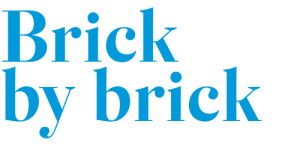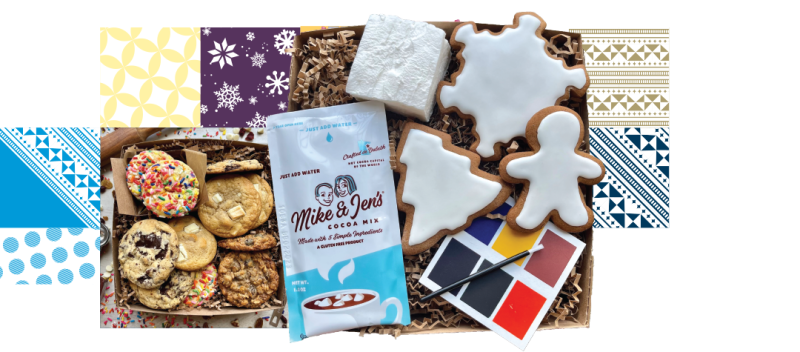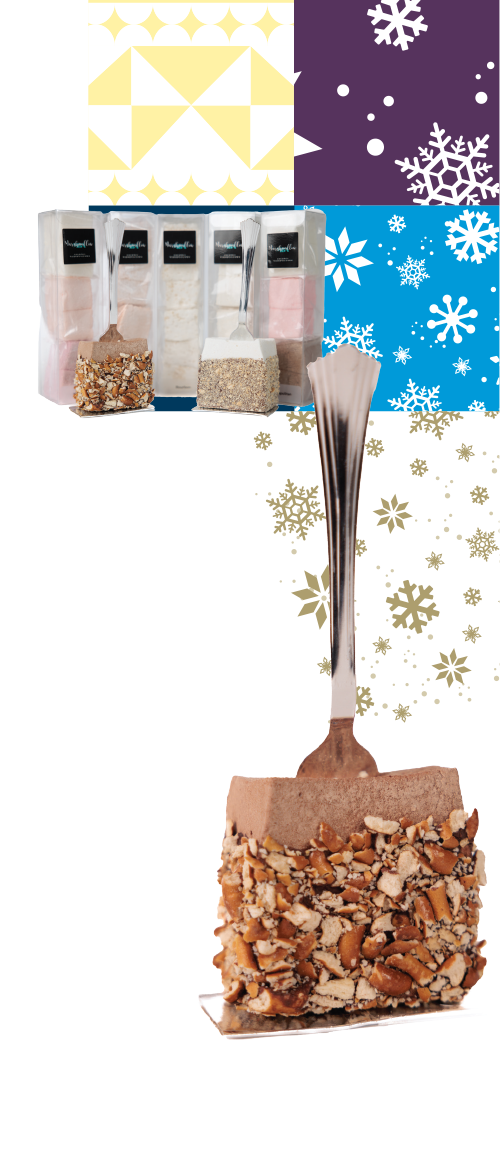When the Giving Gets Tough...
// by Caite Hamilton
Innovators, artisans, activists—GW’s alumni are indeed multifaceted. Lucky for us, many of them channel their expertise into products we can eat, drink, create with and use as decoration. This year’s gift guide features the best of your fellow Revolutionaries’ brainchildren, from a savory marshmallow to a bottle of vodka made with 100 percent America-farmed corn to a monthly box of Lego bricks.
Happy shopping!
Plenty of 9-year-olds have opinions: about what they eat, what they wear, what they play with. But Parker Krex took his opinions one step further—by starting a business that would continue to thrive even as he entered college.
“When I was 9 years old, I asked for a subscription box for my 10th birthday,” Krex, a GW sophomore, says. As it happened, the box arrived during a garage sale Krex was holding to earn money for more Legos. When he opened it, he found a comic book, a pair of socks and an air freshener. “I was very disappointed with the items included. I thought a brick-themed subscription box would be much better.” Luckily, he had two very supportive parents with an entrepreneurial spirit. They invested in his idea and, in 2014, Brick Loot was born.
The company’s bread and butter (brick and butter?) is its subscription boxes: Choose a one-, three-, six- or 12-month subscription, and a box will show up in the mail with four to eight themed Brick Loot items, many of them exclusive to the company: Lego minifigures, custom Lego kits designed by famous Lego designers, accessories, Lego-compatible products and then some. The website, brickloot.com, also offers a robust product line that includes light kits, accessories and building sets—from Titanic (a bestseller, Krex says) to an astronaut (a new release licensed by NASA).
With a business built around Lego, it’s a natural assumption that Krex is himself a master at the craft. Not so, he says. In fact, as the founder of the company, he doesn’t have much time to toy around with Lego anymore at all. But there is a true Lego pro on staff: Tyler Clites, who won the first season of Fox’s “Lego Masters,” serves as the company’s creative director.
“I really enjoy the endless possibilities and creativity that is required,” Krex says. “There are many builders who are able to use bricks in ways you would not expect to create amazing things. It’s just versatile, and it really is for all ages.” In fact, Krex says, around half of Brick Loot’s customers are adults buying for themselves.
Knowing the multigenerational appeal of Lego, in 2019, Krex pitched one of his idols: businessman Marcus Lemonis of CNBC’s “The Profit.” The hour-long meeting with Lemonis’ Camping World buying team included Lemonis himself and resulted in small Brick Loot sets on shelves in every Camping World in the country. Lemonis liked Brick Loot’s ideas about how to combine the toy market with his brand—and he liked the company’s custom sets. Sometimes, 9-year-olds’ opinions are worth exploring.
For 15 percent off subscriptions and purchases at brickloot.com, use code GWMAG.
William Atkins
Genna Tatu, B.S. ’20, had been a knitter all her life—her mom introduced her to it at an early age—but always seemed to start projects and lose patience before they were finished.
“Fast forward to Christmas 2021,” she says, when her mom gifted her a cat sweater crochet kit. “She knew I didn’t know how to crochet and thought the kit would be a great place to start.”
Turns out, mother knows best (“I was immediately ‘hooked’ on crochet,” Tatu jokes). She finished the cat sweater and was soon on to bigger and better projects. She discovered the world of amigurumi—a Japanese form of the craft that, instead of producing two-dimensional items, produces 3D figures like plushies. That appealed to Tatu in particular because, as a child, she loved her collection of stuffed animals.
“Being able to create my very own plushies was a dream come true,” Tatu says. “My childhood self would be very happy and very proud.”
She spent most of January 2022 crocheting a stack of stuffed creatures—chickens, bees, axolotls, turtles among them—and by the end of the month was ready to launch her Etsy store, Crochet by Genna. Since then, she’s had more than 8,000 sales at crochetbygenna.etsy.com, including an early bulk order from a professional flutist who regularly performs in Beyonce’s music videos (a pinch-me moment Tatu will never forget).
The store offers a range of plushies big and small—Tatu says her bestsellers are her mini turtles and her jumbo sunflower turtles—but she creates and sells her own digital patterns as well, releasing two new ones every month, for anyone from beginner to advanced levels. (“I always let people know the stitches that will be used in the pattern, so they can determine whether or not the pattern will be something they can complete,” she says.) If a customer gets stuck on a tricky step, Tatu encourages them to reach out. She’ll send them a message to guide them through it with pictures and occasionally even videos.
Crochet by Genna is a side hustle for Tatu, who by day is a risk and financial advisory consultant at Deloitte in Meridian, Mississippi. At day’s end, she says, she switches roles, putting on her crochet hat and getting to work.
“Crochet is super manual and labor intensive—everything is handmade by me,” she says. “It can't be mass-produced, unlike knitted pieces, so it truly is unique and handmade.” And Tatu takes it a step further, offering custom orders—a rarity in the crochet community.
“I always give the option because people are always looking for a specific plushie to be made,” she says. “It’s very rewarding to bring a customer’s vision to life and know that you created something from scratch for them.”
Use code RAISEHIGH23 for 15 percent off your order at crochetbygenna.etsy.com.
Courtesy of Genna Tatu
Like so many people during the pandemic, Sonia Mansukhani Nandwani, B.B.A. ’18, found herself out of work in 2020. A pastry chef who’d started working in bakeries after graduating from GW, she decided that, rather than scramble to find something new, she’d take the opportunity to figure out her next move.
“As a fun project for myself, I decided to make assorted cookie boxes for my friends and ship them out,” Nandwani says. “Everyone was still getting used to working from home, and I wanted to give some comfort to them.” It wasn’t long after that so dessert—a cookie box gifting company—began in earnest, but the idea formed long before. In fact, Nandwani reserved @sodessert on Instagram in college, after her mom suggested it as a future business name. (“Dessert” refers to the cookies, while “so” references a shorthand her mom uses to address her in text messages.)
This sort of foreshadowing is a theme for the pastry chef. “I always knew I was going to start a business eventually because I come from a family of business owners and merchants on both sides,” she says. “It felt like the right path for me.” She enrolled at GW with a goal of a degree in business administration but by her junior year had decided that the finance concentration wasn’t going to cut it. She switched to entrepreneurship and turned a longtime hobby—baking—into a true passion, planning to start working in the pastry industry professionally after graduating.
“My mom taught me to make cakes when I was really little, and I was always interested in learning how to bake more things,” she says. “Every time the opportunity to bake something new or read a new recipe came up, I would take it.” Nandwani says she’d tear recipes from the family’s magazine subscriptions and save them to make later. Eventually, the collection of recipes turned into a collection of cookbooks, which turned into a mental backlog of inspiration that still influences her recipes today.
But back to the cookies. The core product line—which includes boxes with unique creations like Earl Grey cookies, chocolate cherry biscotti and toasted coconut lime shortbread—remains the company’s gold standard, but Nandwani says the most popular product every year is the gingerbread painting kit.
“We’ve seen this product gifted to little kids, seniors in nursing homes and corporate offices for a team activity,” she says. “It’s amazing to see how customers choose to use your products in ways you never thought of yourself.” The box includes three soft-baked gingerbread cookies with a white icing canvas, an edible paint palette and brush, an extra-large made-in-house marshmallow and hot chocolate mix.
Each so dessert gift box, available online at sodessert.shop, can include a handwritten note and special packaging (“to make each item look and feel like a luxurious gift,” Nandwani says). But the best part is, of course, the cookies.
“All our products are made-to-order with the highest quality ingredients, chef-driven and with no preservatives,” she says. “I’ve never sold a product that I wouldn’t eat myself.”
Use code GWGIFT for $5 off your order through Dec. 15 at sodessert.shop.
Bite into a macaron—that elegant French pastry that resembles a tiny, almost spherical sandwich—and your senses delight in myriad ways: The crunch of the meringue crust gives way to a chewy interior before your tongue searches for the smooth, sweet filling. Today, they can be found nearly anywhere, from Paris—at iconic bakery Ladurée—to Trader Joe’s, where they’re offered in a pack of 12 with flavors like apricot, coconut and fig. But in 2014, the macaron trend was just starting to gain traction throughout the United States—or, at least, most of the United States.
“They didn’t really exist yet in a substantial way in the Midwest,” says Patrick Moloughney, B.A. ’99. He had spent a decade in brand management for Procter & Gamble before striking out on his own to start a business with his husband, Nathan Sivitz. Together they traveled the world—Los Angeles, New York, London, Paris, Brussels—and saw the popularity of the macaron growing. Eager to utilize their talents (Sivitz holds a degree in biology and a passion for baking; Moloughney has business and marketing experience), they started Macaron Bar.
Within a year, they’d opened three Cincinnati locations, offering boxes of 12, 24 or 36 pastries in flavors like birthday cake, salted caramel and cookies and cream (three of their bestsellers, Moloughney says).
In 2015, Mark Santanello, B.A. ’02, joined to oversee employee and HR matters, and in the intervening years, the partners have grown a collaborative team of bakers to develop new ideas and flavors, like those that are released seasonally.
“There are usually about 14 or 15 flavors available to try at any given time,” Moloughney says. “Many that are popular will return each year, but the fun part of our jobs is working with our talented bakers to come up with new and exciting flavor ideas a couple times per year.” Peppermint and gingerbread, chocolate orange blossom, strawberry lemonade, churro and spiced pumpkin are among the seasonal offerings, and are indicative of what appealed to the shop’s owners about macarons in the first place. “Macarons are a premium pastry with an infinite range of colors and flavors that has allowed us to craft a fun yet sophisticated customer experience in our stores,” Moloughney says.
That experience includes not only eating but learning. From day one, the Macaron Bar business plan included baking classes, which are offered weekly at most locations and often sell out weeks in advance. They’re perfect for beginners and advanced-level bakers alike, and they even offer a class for kids.
“Macarons are notoriously difficult, especially in the home kitchen,” says Moloughney. “We wanted to share our experience with everyone who was curious. We knew it would be a great way to engage with the community and welcome them into our kitchens.”
Macaron Bar ships across the U.S. For 10 percent off your order, use code GWSAVES at macaron-bar.com.
Courtesy of Macaron Bar
As if he could forget, Warren Brown, J.D. ’98, M.P.H. ’98, says he still remembers the day he shared the stage with Oprah Winfrey 20 years ago—as a guest on her TV show. The theme of that episode was “What should I do with my life?” and Brown had been tapped for an appearance because he’d recently left practicing law to open what was quickly becoming a very successful bakery.
Brown has never been afraid of a challenge—he quit law, learned to bake and opened CakeLove within the span of just a few years. The Washington, D.C.-based pastry shop served as the jumping-off point for Brown’s baking career, prompting four cookbooks (two with “CakeLove” in their name and two others on pie and food traditions in every state), a hosting gig on Food Network’s “Sugar Rush” and, eventually, Don’t Forget Cake.
“I began with CakeLove way back in 2002 and really enjoyed it, but winds of market changes began once online shopping became a thing and retail began to hint that it would look like it does today. Not dead, just different,” Brown says. “What I really enjoy about baking is making product. Innovative items. It just thrills me.”
With Don’t Forget Cake, Brown figured out a way to put the beloved dessert…in a jar. Each of the containers, which are available at dontforgetcake.com as well as Giant and some Wal-Mart stores, serves three to four people (technically, though Brown says he can’t comment on how many people down one on their own) and comes in flavors like red velvet (a bestseller), tres leches (Brown’s personal favorite), cookie dough and key lime. Oh, and there’s birthday cake, too.
“There’s magic in cake,” Brown says. “It’s fantasy. It’s guilty pleasure. It’s a hidden gem before it’s sliced. It’s heavy with anticipation before the first bite--will it be good, and worth it? But it’s also simple revelry in youth. It always makes me think of turning 5; that’s the earliest birthday cake I remember. All of that makes for a fun lane to be in.”
And what about the name? Brown says that came from his retail days, when customers would call with last-minute cake orders.
“A lot of times the party was happening later that day, but no one had ordered a cake,” Brown says. “Lots of party prep and planning, but the cake got overlooked. I like to warn people: Don’t forget cake!”
Use code GWGW for 20 percent off your order at dontforgetcake.com through Jan. 31, 2024.
Courtesy of Warren Brown
How can you use a marshmallow? Let Amy Hughes, M.B.A. ’12, count the ways: as a frothy garnish for coffee, tea or cocktails (“if you can stop yourself from stabbing them and just eating them before they melt completely!” she says), as an extra layer atop fresh-from-the-oven brownies, transformed into a flavorful fondant for cake, as a twist on meringue for pies. And, of course, they’re a key component in gourmet s’mores.
Hughes spreads the gospel of marshmallows daily with her business, MarshmallowMBA, which she started on a whim after a friend she’d gifted marshmallows for Hanukkah said, “I don’t know why you’re not selling these things. You could be the marshmallow MBA.”
Hughes already had a business degree and more than 20 years as a federal consultant under her belt when, as she puts it, she “blew up her life” and got her new business underway.
The risk has paid off. In 2022, the company won the Best Innovation Award from Retail Confectioners International for its Bee Kind marshmallows, a collection that uses no corn products and is infused with natural herbal blends that enhance relaxation. Wait, what?
“We like to say, ‘Forget everything you think you know about marshmallows’ when inviting potential customers to sample our confections,” Hughes says. Indeed, the shop’s offerings are unconventional by design (“I love having the opportunity to play with candy as a ‘more than’ concept,” she says), from flavor to texture. To date, she’s developed an energy marshmallow and an athlete performance/recovery marshmallow in addition to the award-winning Bee Kind line. She’s even invented a s’more on a fork, er, a s’mork. (“Think gourmet candy apple, but replace the apple with an extra-large gourmet marshmallow,” Hughes says.)
Popular with retailers, as well as for wedding and special event favors, the s’mork started as a vanilla marshmallow dunked in chocolate and covered in crushed graham crackers but has evolved to include flavors like birthday cake, double-chocolate sea salt, and—Hughes’ dad’s favorite—chocolate peanut butter pretzel. MarshmallowMBA offers a range of flavors for the entire product line: family-friendly, cocktail-inspired and even savory flavors they refer to as “weirdly delicious.” It’s the savory ones that Hughes’ own palate prefers—the bourbon marshmallow (her current favorite, though Old Bay caramel and mocha frappe are also vying for the top spot) has a “smoky grown-up vanilla flavor.”
Still, the more traditional options are MarshmallowMBA’s most popular: sea salt caramel, birthday cake, blood orange, cinnamon roll, raspberry rosé and Naughty Girl Scout. In all, the company has a library of more than 150 flavors, all gluten-free, with no egg, soy, fat or preservatives. And they have a texture that will surprise those of us most familiar with store-bought brands.
“They have been described as pillowy and cloud-like,” Hughes says. “People often expect them to be hard, so that surprises them. And even though they are light in texture, they are rich in flavor.”
With an already robust product line, found online at marshmallowmba.com, where does MarshmallowMBA go from here? Not surprisingly, onward. Hughes plans to increase manufacturing capabilities with new facilities and is considering the possibility of a food truck or marshmallow café. She’s also on the hunt for collaborators—companies with products that can be used in marshmallows or that complement them.
“In the near term, however,” says Hughes, “I am focused on the unique opportunities I have to expand people’s ideas of what marshmallows can be.”
For 10 percent off your order on marshmallowmba.com, use code RAISEHIGH.
“Dreamy décor with a purpose.” That’s what Melissa Moriarty, B.A. ’07, says is the “North Star” of her company, Azulina Home. The word “purpose” is twofold: The products must be useful, but they must also have a broader social influence.
“I have seen firsthand the positive long-term impact of supporting small-batch makers, and that’s the kind of impact I would like to have in my lifetime,” Moriarty says. “I believe it’s important to support and invest in heritage techniques and traditions—it results in a richer experience and also ensures that those time-honored weaving techniques get passed down to the next generation.”
Azulina Home offers a core product line of bath mats, doormats, runners and pillows, all handmade by Colombian artisans. In fact, Colombia was the inspiration for the whole company. Moriarty moved there in 2011 after falling in love with Medellín on vacation (“I sold all my stuff and booked a one-way ticket, thinking I would live there six to 12 months max. …I was there for six years!” she says) and, more specifically, while on a trip to El Carmen de Viboral in search of a gift for the wedding of her best friend, Maggie Weiss Maloney, B.A. ’07. A little town east of Medellín, it’s known as La Perla Azulina del Oriente (“the blue pearl of the east”), famous for its beautiful ceramics.
“I was in complete awe of the artistry and pottery-making tradition,” Moriarty says. “Next thing I knew, I was shipping a 20-foot container of blue-and-white hand-painted ceramics to the U.S., and that’s where Azulina began!”
Though she pivoted away from ceramics and into soft goods in 2017, she kept the core tenets of the business intact: working with artisans in Colombia to create textiles and rugs “to be a part of creating a beautiful, calm home, filled with goods that are well designed and thoughtfully produced.” Moriarty meets each artisan personally, and never works with an intermediary, which ensures that 100 percent of the payment goes directly to the weaver.
The “Cali” bath mats—100 percent cotton and loom woven—have remained Azulina’s No. 1 bestsellers for the last three years. Moriarty says customers love them because they’re sturdy and easy to clean (machine-washable!). But the company’s owner says she’s partial to the chunky wool pillows.
“They have a modern, organic look that instantly elevates a room,” she says. “That is what I currently have on my bed.”
She has some hand in the design of the products—which are sold at azulina.com and in more than 30 stores across the U.S., Canada and the Caribbean, including Jenni Kayne, Restoration Hardware and Shoppe Amber Interiors—and will often weigh in on color edits, but she relies on the traditional weaves the Colombian artisans have perfected over the years.
“When I set out to create Azulina, I purposefully chose to design and produce handmade items (as opposed to machine made),” she says. “I much prefer to fill my home with beautiful, handmade pieces, and we want to work with customers who prefer the same.”
For 20 percent off sitewide at azulina.com, use code GW2023.
People sometimes throw around the phrase, “Put your money where your mouth is.” Dan Simons, B.B.A. ’92, takes it literally. A founding partner of Farmers Restaurant Group, Simons has built his career around supporting farmers and promoting food that’s locally sourced and made from scratch. Head to the Farmers Restaurant Group website, and the first thing you see is a giant number: 53,090 at the time of this writing. That’s the number of farmers who own a stake in the company.
“Truly, the farmers own the majority, which means they get the majority of the profit that we produce. This affects us deeply—we run the company ‘through the eye of the farmer,’” Simons says, a phrase they’ve trademarked. “We think long-term, we prioritize stakeholders in addition to profit, like community, people, the environment—because farmers need these things to survive, and they think about giving their business to the next generation.”
The concept continues to thrive. As a “Forbes” article noted in 2017, restaurants under the Farmers Restaurant Group umbrella consistently show up at the top of the list on Washington, D.C.’s corner of Open Table—a good indication that guests like what they taste—and a quick search suggests that’s still true today.
Of course, like a lot of people in the restaurant industry, Simons didn’t start at the top of the food chain. He started working in bars and restaurants while attending GW, working the door and washing beer mugs at the Exchange Saloon on G Street. He learned to bartend and was hired at TGI Fridays in 1990.
“I fell in love with the biz from the ground up,” he says, “and that feeling has never left me.”
In 2017, the brand launched Founding Spirits, a liquor line that includes vodka, dry gin, bourbon, rye and three types of rum—each one utilizing ingredients (wheat, barley, corn) from family farmers.
“As a restaurant owner, and specifically, one that is partnering with American family farmers, I’m always on a quest to use more family-farmed product,” Simon says. “This means unbundling the supply chain, avoiding the corporate producers.” Figuring out how to distill their own alcohol, he says, is part of the company’s natural evolution to bring transparency to the supply chain. They use the spirits in their restaurants’ cocktails, too.
“Vodka pays the bills, as we say in the booze business,” Simons says, but the restaurateur’s favorite is the company’s new dark rum, one of three versions of rum Founding Spirits just added to its lineup. Plus (“Shhhh!” he says), a collaboration with a producer in Mexico and a tequila are on the way. Find Founding Spirits online for nationwide shipping at foundingspirits.com, or pick up a bottle at one of the Farmers D.C. locations.
GW alumni can receive a 10 percent discount when you order online for pickup at one of their D.C. locations. Use promo code GW10 when ordering at order.farmersrestaurantgroup.com. Their D.C. locations include Founding Farmers DC on Pennsylvania Avenue near GW; Founding Farmers & Distillers on Massachusetts Avenue at 6th Street, NW; and Farmers Fishers Bakers on the Potomac at Washington Harbour in Georgetown.


















